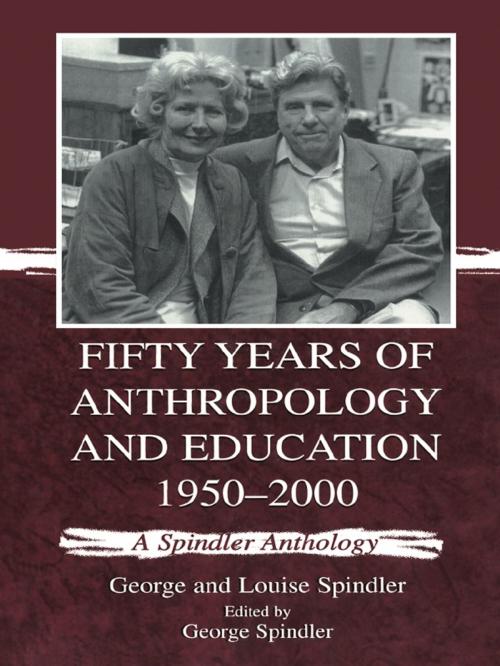Fifty Years of Anthropology and Education 1950-2000
A Spindler Anthology
Nonfiction, Reference & Language, Education & Teaching| Author: | George and Loui Spindler | ISBN: | 9781135661441 |
| Publisher: | Taylor and Francis | Publication: | June 1, 2000 |
| Imprint: | Psychology Press | Language: | English |
| Author: | George and Loui Spindler |
| ISBN: | 9781135661441 |
| Publisher: | Taylor and Francis |
| Publication: | June 1, 2000 |
| Imprint: | Psychology Press |
| Language: | English |
George and Louise Spindler are widely regarded as significant founders of the field of educational anthropology. This book brings together their best, most seminal work from the last 50 years--a time frame representing the developmental epoch of the field--and binds them together with a master commentary by George Spindler. Previously scattered over a wide range of publications, the articles collected here allow for a unified view of the Spindlers' work and of the development of the field.
The book opens with an insightful Foreword by Henry T. Trueba, a fascinating piece titled "A Life With Anthropology and Education: Interviews With George and Louise Spindler by Ray McDermott and Frederick Erickson," and George Spindler's "Previews" essay which gives the reader a grasp of the whole to which the parts of the book contribute. These pieces frame and contextualize the work that follows.
In Part I, Character Defining, many of the major themes of this volume are first encountered; this section sets the stage for what follows. Part II, Comparisons, focuses on comparison, which the Spindlers view as essential to an anthropological approach. Part III, Ethnography in Action, is devoted to the explicit exposition of ethnographic methods (though actually every piece in the book is a demonstration of method). Part IV, American Culture, moves from a traditional representation of American Culture to a processual analysis of how the culture is transmitted in real situations, and finally to an interpretation of right-wing actions that seem to constitute a reactive movement; the implications for education are pursued. Part V, Cultural Therapy , explains what cultural therapy is and how it may be applied to teachers and students. The volume concludes with Part VI, Orientation, Susan Parman's overview of the works of the Spindlers that spans their whole career.
George and Louise Spindler are widely regarded as significant founders of the field of educational anthropology. This book brings together their best, most seminal work from the last 50 years--a time frame representing the developmental epoch of the field--and binds them together with a master commentary by George Spindler. Previously scattered over a wide range of publications, the articles collected here allow for a unified view of the Spindlers' work and of the development of the field.
The book opens with an insightful Foreword by Henry T. Trueba, a fascinating piece titled "A Life With Anthropology and Education: Interviews With George and Louise Spindler by Ray McDermott and Frederick Erickson," and George Spindler's "Previews" essay which gives the reader a grasp of the whole to which the parts of the book contribute. These pieces frame and contextualize the work that follows.
In Part I, Character Defining, many of the major themes of this volume are first encountered; this section sets the stage for what follows. Part II, Comparisons, focuses on comparison, which the Spindlers view as essential to an anthropological approach. Part III, Ethnography in Action, is devoted to the explicit exposition of ethnographic methods (though actually every piece in the book is a demonstration of method). Part IV, American Culture, moves from a traditional representation of American Culture to a processual analysis of how the culture is transmitted in real situations, and finally to an interpretation of right-wing actions that seem to constitute a reactive movement; the implications for education are pursued. Part V, Cultural Therapy , explains what cultural therapy is and how it may be applied to teachers and students. The volume concludes with Part VI, Orientation, Susan Parman's overview of the works of the Spindlers that spans their whole career.















